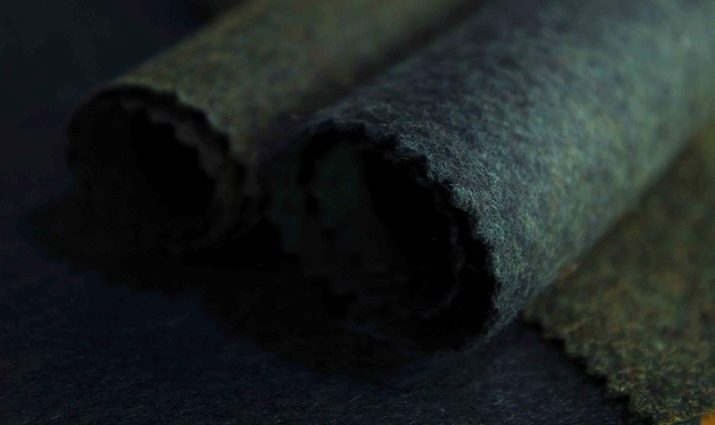What is a molton and what is made of this fabric?

The range of fabrics is huge today. In textile industries, both thin and thick fabrics with different texture and structure are used. Such material as molton is in demand. In this article we will tell you what it is and what is made of the specified fabric.



What it is?
Molton is an excellent fabric of high density and softness. It has a good texture and is pleasant to the touch. The material can be obtained from both natural and synthetic raw materials, it can be a single-color or multi-colored type of textile. Molton is a woven fabric characterized by the following main parameters:
- fleecy type surface;
- double-sided fleece;
- double-faced filamentous plexus.
It is worth identifying the composition of the woven material in question. Moltons are made mainly from high quality cotton or woolen yarn. Woolen fabrics are made today by means of the simplest twill weave of threads. As for the cotton options, they are made with the usual plain weave.


The fabric in question is very popular because it has many positive qualities. Here are the most important ones.
- The material is soft. Molton is dense and very pleasant to the touch. This is especially true for cotton variations.
- Molton has high strength characteristics and abrasion resistance.
- The fabric boasts excellent hygienic qualities: the molton has the ability to absorb moisture, demonstrates high levels of air permeability.
- The matter is not subject to easy wrinkling.
- High-quality fabric can hold the correct shape very well without deforming.
- Molton has an increased degree of shading.
Such a popular material has not only advantages, but also disadvantages.
- Molton can shrink when washed under hot water conditions.
- If you plan to wash the material, you must use only gentle and delicate types of washing powders.


History of appearance
There are several versions of the appearance of the name "molton", which would explain the origin of this material. Although there is still no consensus. The most widespread and popular variant is considered, which indicates that this type of fabric first appeared on the territory of France, therefore it was named from the word mollet - "soft". There is another version, on the basis of which the name of the molten fabric is associated with the release of the cloth "Melton". It was in this town that the production of castor cloth, known throughout the world, began.
In the first years after its release, the molton was presented in the form of an excellent woolen cloth. It was woven from a special worsted yarn with high strength and smoothness. The thread, which was characterized by uniformity along its entire length, made it possible to obtain a wonderful fabric with a very good texture and fluffy fleece.
The basis was a plain yarn of a light shade. It could be bleached or painted in a single color. Rarely used in the production of raw materials of the melange type.

Initially, the thread weaving method was twill. The fabrics made were covered with villi, under which there were diagonal scars. The fabric was used for sewing high-quality warm outerwear and various items of underwear. Most of the products have been tailored specifically for women and young users. The cost of the material was quite high from the start. Excellent insulated blankets and beautiful bedspreads from molton began to be made a little later.
At the peak of popularity in our country, the material in question was in the 18th century. This fact is confirmed by portraits of a large number of noble persons of the specified period in history. Molton acted as an element of wealth and prestige. Very effective and solid clothes were sewn from thin varieties of this fabric, and outerwear from more compacted ones.
Over time, molten fabric began to be produced using cotton fibers. Plain weaving of threads began to be used. At the same time, a rather thick, high-density pile was preserved.


Basic properties
Today there are many different types of pile fabrics. Everyone can choose the best option for every taste and budget. Despite this, the antique molton is still relevant and attracts many famous fashion designers. Designers create wonderful molton clothes not only for adults, but also for children. The relevance of the material under consideration is easily explained by its basic properties.
- Molton is a quality material of natural origin. The fabric is environmentally friendly, absolutely safe for users of any age group.
- Molton items are characterized by high strength and long service life.
- Molton clothes can perfectly retain heat and also protect from the wind. That is why molton outerwear is of such high quality.
- Molton demonstrates the highest level of touch comfort.
- The material is hygroscopic.
- An important property of Molton is its beautiful appearance. Attractive and stylish things are obtained from the material.
- The fabric is characterized by the lack of pilling properties.
- Molton is capable of absorbing noise, is not transparent and translucent.

Products made from the fleecy fabric in question can be dyed in a variety of colors without problems. In the composition of modern molton, not only wool or cotton, but also other components can be present. We are talking about elastane or polyester.
Thanks to such components, the molton becomes more practical, acquires better quality characteristics.



Types of fabric
There are several varieties of molton. Let's highlight the main features of each option.
- Classical. The classic category includes the usual molton, which is double-sided and pile.

- Satin. And this fabric is one-sided. On one side, it looks like a regular molton, and on the other, like an atlas.

- Stage. Woven fabrics are characterized by increased dimming values, coupled with sound absorption. The stage molton almost does not wrinkle, it can easily straighten up. It is characterized by a compacted structure.

- Muleton. Synthetic fabric, one of the layers of which is entirely composed of polyester. Mouleton can also be presented as a combined or natural version.


- Bolton. This is the name of the one-sided type canvas. Has a rough surface. Bolton is a decorative molton.


Application
If we talk about woolen material, then it is usually used to create warm and high-quality mattress covers, blankets and heat-preserving clothing for both adults and children. On sale you can find many quilted bedspreads made of molton. Popular wear-resistant products like these are perfect for toddler cribs and adult bedrooms. Such products are produced both in plain colors and decorated with various decorative images or prints.
High-quality stage subtype molton is used in the creation of decorative items and backdrops. The surface of this material is matte, does not reflect light, and therefore does not exhibit gloss.
As a more economical option, this molton can be a substitute for velvet in the manufacture of curtains and curtains.


But it should be borne in mind that the matter in question does not show a velvet depth of color, and it looks poorer. Due to the characteristics of noise isolation, molton is often used as an acoustic material in recording studios, as well as in the manufacture of various musical instruments.
As for a high-quality cotton-type molton, it is best suited for babies. Amazing baby clothes of underwear look are sewn from it, as it sits perfectly on delicate skin. In addition, the molton is hygroscopic, so it is definitely suitable for children. Very good bedding sets, linens, suits, sweaters, warm linings of high density also come out of this fabric.


Care
Despite the fact that the molton is a practical textile fabric, it still needs proper care. This will ensure the preservation of attractiveness and fluffy pile. Let us examine a few useful recommendations that relate to competent nursing operations in relation to Molton matter.
- Items made with this popular pile fabric can be washed by hand or in the drum of the washing machine. If technology is used, then it is necessary to set only gentle modes. In this case, detergents should imply the most mild formula so as not to harm the material.
- So that after the washing procedure, the fleecy matter does not give unwanted shrinkage, it is advisable to limit the temperature indicators of water heating to 30 degrees Celsius. It is strongly not recommended to go beyond this value, as this can provoke deformation of the molton product.
- Clothes made from molten textiles do not have to be ironed too often and hard.If necessary, ironing is allowed only from the wrong side of the material. In this case, the product should be slightly damp. The temperature controller must be installed in a position that will suit the type of molton fibers.
- It is permissible to send a soiled Molton item to dry cleaning.
- It is not allowed to wash clothes made of molton in the same drum with clothes made of other materials.
- The allowed washing time for the items in question is no more than 1 hour.
- If the spin is started during washing in the machine, then it should only take place at the minimum speed.
- Storage of molton products should be carried out only turned inside out and in a dry room. In the latter, high-quality air circulation should take place.
It is advisable to ensure that the direct rays of the sun do not fall on the molten things.











